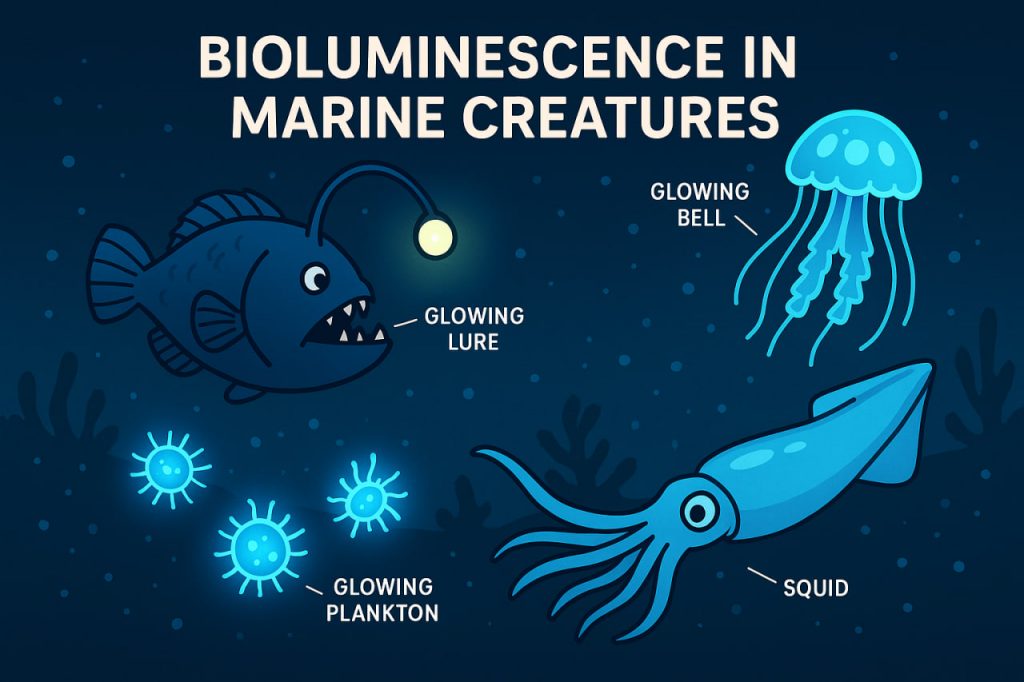Beneath the ocean’s surface lies a world illuminated by light that doesn’t come from the Sun. Bioluminescence—the ability of living organisms to produce light—is a fascinating and widespread phenomenon among marine creatures. From glowing jellyfish to flashing squid, bioluminescence serves many purposes in the dark depths of the sea.
What Is Bioluminescence?
Bioluminescence is the production of light by a chemical reaction within an organism. It typically involves a molecule called luciferin reacting with oxygen, often with the help of an enzyme called luciferase. The result is cold light—meaning it gives off almost no heat.
This adaptation is particularly useful in the deep sea, where sunlight does not penetrate, and visibility is extremely low.
Why Marine Creatures Glow
Bioluminescence is not just for show—it has evolved for survival. Here are the most common purposes:
- Attracting Prey
Some deep-sea predators use light to lure smaller animals. For example, the anglerfish has a glowing lure that it dangles in front of its mouth. - Camouflage
Certain fish, like the lanternfish, use light on their bellies to match the faint light above, making them less visible to predators below. This is called counter-illumination. - Communication
Squid and shrimp use flashes or patterns of light to signal to each other, often during mating or territorial displays. - Defense
Some organisms eject bioluminescent fluid to distract predators. Others flash suddenly to startle attackers or to attract larger predators that might attack their pursuer. - Mating
Firefly squid and other species use light to find mates in the dark ocean.
Examples of Bioluminescent Marine Life
- Anglerfish – Uses a glowing lure to catch prey
- Jellyfish – Flash light as a defense mechanism
- Dinoflagellates – Single-celled plankton that glow when disturbed (causing glowing waves)
- Hatchetfish – Has light organs for camouflage
- Vampire squid – Emits light to confuse predators
Over 75% of deep-sea animals are bioluminescent, especially below 200 meters where sunlight fades completely.
How Is Bioluminescence Different from Fluorescence?
- Bioluminescence is generated from within the organism through a chemical reaction.
- Fluorescence is the absorption and re-emission of light from an external source (like UV light).
Only bioluminescence creates its own light in complete darkness.
Human Applications
Scientists are studying bioluminescence for use in:
- Medical imaging and diagnostics
- Environmental monitoring (detecting pollutants)
- Developing sustainable lighting
- Military and emergency signals
Nature’s glow has inspired innovations in technology and medicine.
Conclusion
Bioluminescence is one of the ocean’s most remarkable adaptations. In the pitch-black depths, glowing light becomes a tool for survival, communication, and even hunting. As we explore deeper into the sea, we continue to discover new glowing creatures—each with its own evolutionary story written in light.
Glossary
- Bioluminescence: Light produced by a living organism through a chemical reaction
- Luciferin: A molecule that reacts with oxygen to produce light
- Luciferase: An enzyme that speeds up the light-producing reaction
- Counter-illumination: Using light to blend in with ambient light from above
- Dinoflagellates: Tiny plankton that can glow when disturbed


